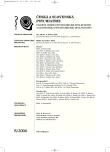Bipolar Affective Disorder in Children and Adolescents
Authors:
I. Dudová; M. Hrdlička
Authors‘ workplace:
Dětská psychiatrická klinika 2. LF UK a FN Motol, Praha
přednosta prof. MUDr. M. Hrdlička, CSc.
Published in:
Čes. a slov. Psychiat., 102, 2006, No. 8, pp. 423-430.
Category:
Comprehensive Reports
Overview
Bipolar affective disorder in children and adolescents has been closely studied as late as in the last decade. An overview article brings remarks on classification, etiology, imaging methods results, and epidemiology of the disorder. The clinical description of the disorder focuses on age related character of some symptoms. In the differential diagnostics ADHD, conduct disorder, schizophrenia and schizoaffective disorder, substance use, anxiety disorders, posttraumatic stress disorder, agitated depression, as well as borderline personality disorder are mentioned. Some of the disorders listed above can be comorbid disorders of the bipolar disorder in childhood and adolescence as well. Illness course in children and younger adolescents, in comparison to adults, is rather non-episodic, chronic, with rapid cycling and mixed episodes. Mood stabilizers, SSRI antidepressants, benzodiazepines and antipsychotics, especially atypical, are common treatment options. The overview is supplemented by a case report.
Key words:
bipolar affective disorder, childhood, adolescence, psychopathology, drug therapy.
Labels
Addictology Paediatric psychiatry PsychiatryArticle was published in
Czech and Slovak Psychiatry

2006 Issue 8
Most read in this issue
- Bipolar Affective Disorder in Children and Adolescents
- Stimulation of Prefrontal Cortex and Therapy of Negative Symptoms of Schizophrenia
- Case Reports - Other Association
- Risk Factors of Child and Adolescent Suicidality
